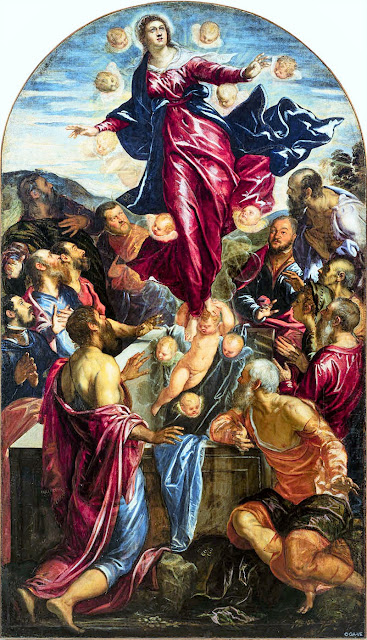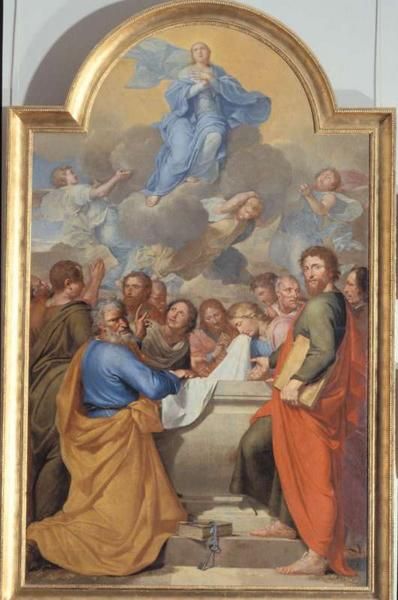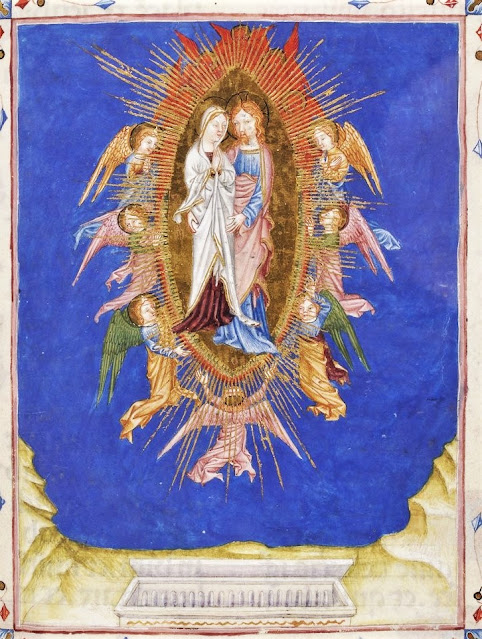Alleluia, alleluia.
Mary is taken up to heaven; a chorus of angels exults.
Mary is taken up to heaven; a chorus of angels exults.
Alleluia, alleluia
Gospel Acclamation for the Solemnity of the Assumption of the Blessed Virgin Mary, August 15
Gospel Acclamation for the Solemnity of the Assumption of the Blessed Virgin Mary, August 15
August 15 is a great day of celebration for the Christian Church, both East and West. The day commemorates the bodily Assumption of the Blessed Virgin Mary, the Theotokos (Mother of God), into heaven. She is assumed as a gift from her divine Son and, thus, has anticipated the glorification which is the destiny of all who have been saved by Christ.1 As previously discussed (here), this is a very ancient belief of the Church, although it was not declared an article of faith (a dogma) until 1950. There is no doubt about the antiquity of the belief, as it has been celebrated in the liturgy and in the visual arts for many centuries.
As I mentioned in my previous essays on Mary's Preparation for Death (click here) and her Death, Mourning and Funeral (click here), there are many legends associated with the basic belief that, at the end of her mortal life, Mary’s body and soul were taken up to heaven. There is an Old Testament precedent in the taking up of Elijah into heaven in the fiery chariot (2 Kings 2:1-11).
As I mentioned in my previous essays on Mary's Preparation for Death (click here) and her Death, Mourning and Funeral (click here), there are many legends associated with the basic belief that, at the end of her mortal life, Mary’s body and soul were taken up to heaven. There is an Old Testament precedent in the taking up of Elijah into heaven in the fiery chariot (2 Kings 2:1-11).
The Assumption
In both the verbal and visual traditions the most important element in the Assumption is that Mary does not go to heaven through her own power, she is always taken there. This is the difference between the “assumption” of Mary and the “ascension” of Jesus. Jesus ascends to heaven by His own power, through His right as Lord and Savior. He does not need help, Mary always does.Assistance from Christ
She is assisted by Christ Himself in early images.,%20c.%201020-1040_Paris,%20BNF_MS%20Latin%2018005,%20fol.%20118v.jpg) |
| Dormition of the Virgin from the Sacramentary of Verdun German (Reichenau), c. 1020-1040 Paris, Bibliotheque Nationale de France MS Latin 18005, fol. 118v |
 |
| Dormition of the Virgin from a Gospel Book German, 1st half of the 12th century, Paris, Bibliotheque National de France MS Latin 17325, fol. 51v |
Taddeo di Bartolo, The Assumption of the Virgin Mary
Italian, c. 1410
Vatican City State, Pinacoteca Vaticana
Another affecting picture in which the Son comes to bring his mother home in the flesh. Meanwhile the grieving Apsotles seem unaware that her body is no longer there. As she is lifted by Christ we can see behind her the flowers that the tradition says filled the space left by her body. |
| Andrea Mantegna, Christ with the Virgin Italian, c. 1460-1464 Ferrara, Pinacoteca Nazionale |
 |
| Master of Marienlebens, The Assumption of the Virgin Mary Munich, Bayerische Staatgemäldesammlungen, Alte Pinakothek |
 |
The Assumption of the Virgin Mary French, Late 15th CenturyAbbeville, Musée Boucher-de-Perthes I'm particularly fond of this picture, which shows two parts of the story. At the bottom, Christ appears making a blessing gesture and holding a crystal orb as angels begin to lift Mary's body from the tomb. The assembled Apostles, including Saint Thomas kneel at the left side and front. They are joined by Mary Magdalene and angels, who also kneel. Behind Christ is a group of people in 15th Century attire, who appear to be standing. Perhaps they are donors. In the upper half Mary is seen ascending with the help of angels toward Christ who stands in heaven. He is standing in front of a double marble throne, with the orb at his feet. His arms are outstretched in welcome and his right hand points to a cushion set on the empty seat of the throne. This will be Mary's seat in heaven. |
Assistance from Angels
Mary is often propelled upward by the assistance of angels who pull and/or push her into heaven. Sometimes we also see them lifting her from the tomb as well.
,%20c.%201075_Paris,%20BNF_MS%20Latin%20819,%20fol.%2097v.jpg) |
The Assumption of the Virgin Mary From a SacramentaryFlemish (Liege), c. 1075 Paris, Bibliotheque nationale de France |
 |
The Assumption of the Virgin Mary
French, c. 1170
Senlis, Cathedral of Notre-Dame
In this charming relief, the angels are starting to remove her body from the tomb as one of the Apostles stands to the right. He may be the Apostle John, to whom Jesus entrusted his mother from the Cross. The Bible and a long-standing tradition holds that John took her to live with him in Jerusalem and later in Ephesus. The tradition also suggests that at her request she returned to Jerusalem to die and was buried there in the presence of all the Apostles still living. |
,%20c.%201400-1425_London,%20British%20Library_MS%20Additional%2016997,%20fol.%20163%20(2).jpg) | |
|
 |
The Assumption of the Virgin Mary French, 15th CenturyBourges, Musée du Berry |
,%20c.%20Early%201470s+LA%20Getty_MS%2021%20(2).jpg) |
| Master of Morgan 366, The Assumption of the Virgin Mary French (Tours), c. Early 1470s Loa Angeles, J. Paul Getty Museum MS 21 |
 |
| Assumption of the Virgin Mary from Book of Hours and Prayers South Netherlands, c. 1490-1500 The Hague, Koninklijke Bibliothek, MS KB 134 C 47, fol. 201r |
 |
| Master of James IV of Scotland, The Assumption of the Virgin Mary Flemish (Bruges), c. 1510-1520 Los Angeles, J. Paul Getty Museum MS Ludwig IX 18, fol. 148v |
Visual Development
However, as was true for images of the Ascension, there is a development in how the elements of the transport are presented.The Mandorla
In the Middle Ages and the early Renaissance, Mary is frequently seen surrounded by a mandorla. It is this mandorla, whether a closed oval shape or a platform made of clouds, rather than her body that the angels touch as they propel her upward._BL_MS%20Harley%202908,%20fol.%20123v.jpg) | |
|
 |
| Andrea Orcagna, Tabernacle of the Dormition and Assumption Italian, 1359 Florence, Orsanmichele |
,%20c.%201370-1380_Paris,%20BNF_MS%20Nouvelle%20acquisiton%20francaise%2015940,%20fol.%20.67v.jpg) |
| Master of the Livre du Sacre and Workshop,Assumption of the Virgin Mary From Speculum historiale by Vincent of Beauvais French (Paris), c. 1370-1380 Paris, Bibliotheque nationale de France MS Nouvelle acquisition francaise 15940, fol. .67v |
,%20c.%201375-1400_London,%20British%20Library_MS%20Yates%20Thompson%2045,%20fol.%20228v%20Full.jpg) | |
|
 |
| Masolino da Panicale, The Assumption of the Virgin Mary Naples, Museo Nazionale di Capodimonte Here, instead of being a solid shape, the mandorla is composed of a squad of flying cherubim. The idea of the solid shaped mandorla begins to fade. |
 |
| The Assumption of the Virgin Mary English, Second Half of 15th Century London, Victoria and Albert Museum |
 |
| Jean Fouquet, The Assumption of the Virgin Mary French (Tours), c. 1450-1460 Chantilly, Musée Condé MS 71, fol. 84 Again, the solid mandorla shape has been replaced by an oval formation of cherubs. |
 | |||
Jan Rombouts, The Assumption of the Virgin Mary Flemish, c. 1505-1510 New York, Metropolitan Museum of Art
|
 |
| Domenicho Ghirlandaio, The Assumption of the Virgin Mary Florence, Church of Santa Maria Novella, Tornabuoni Chapel |
 |
| Gerolamo da Vicenza,The Assumption of the Virgin Mary London, National Gallery |
 |
| Filippino Lippi, The Assumption of the Virgin Mary Rome, Church of Santa Maria sopra Minerva |
 |
| Marcellus Koffermans, The Assumption of the Virgin Mary Chicago, Art Institute |
 | |
|
 |
| Titian, The Assumption of the Virgin Mary Venice, Church of Santa Maria dei Frari |
 |
| Attributed to Vincent Raymond de Lodeve, The Assumption of the Virgin Mary Italian, c. 1523-1534 London, British Library MS Additional 35254L-M, fol. L |
Correggio
A pinnacle was reached with the spectacular depiction of the Assumption in the dome of the Cathedral of Parma by Correggio. In a swirling mass of angels and watched by saints Mary is raised to heaven where a dramatically foreshortened Jesus hovers to receive her with outstretched arms.
 |
| Correggio, The Assumption of the Virgin Mary Parma, Cathedral |
Baroque in character, almost 100 years before the advent of the Baroque style, Correggio's aerial display was a dramatic revelation. Details show how difficult it was to take in for those who saw it first.
This detail shows Mary seated in the clouds and surrounded and uplifted by angels as she is assumed into heaven. Her arms are spread in greeting as she looks up at her Son.
In the apex of heaven Jesus, seen in severe foreshortening, also stretches out his arms to welcome her. The foreshortening is so severe that his dangling legs are the most prominent thing the viewer sees. Although the evidence of an early copy suggests that the view was quite modest, someone appears to have objected and what looks like baggy green shorts were added above his knees at some point.
The Later Images, the Sixteenth Century
The dramatic earth bound view of Correggio's masterpiece could not easily be repeated nor was it practical for most of the commissions received by artists. So, eventually, the scene generally becomes one in which Mary, amid clouds of glory, is bodily propelled by the angels who push her from below and lift her from above, as she looks joyfully upward toward her heavenly destination.
 |
| After Raphael, The Assumption of the Virgin Mary From the Life of the Virgin Series Flemish, c. 1535 Boston, Museum of Fine Arts |
 |
| Jacopo Tintoretto, The Assumption of the Virgin Mary Italian, c. 1550-1555 Venice, Gallerie dell'Accademia |
 |
| Marco Pino, The Assumption of the Virgin Mary Italian, c. 1550-1600 Douai, Musée de la Chartreuse |
 |
| Paolo Veronese.The Assumption of the Virgin Mary Italian, 1558 Venice, Basilica of Saints Giovanni and Paul |
 | |
|
 |
| Annibale Carracci, The Assumption of the Virgin Mary Italian, c. 1587 Madrid, Museo Nacional del Prado |
 |
| Otto van Veen, The Assumption of the Virgin Mary Flemish, c. 1600 Munich, Bayerisches Staatsgemäldesammlungen, Alte Pinakothek |
The Seventeenth Century
Rubens
Like Correggio in the sixteenth, another artist at the beginning of the seventeenth century, had a great impact on subsequent artists. This was Peter Paul Rubens. He drew his inspiration from a stay in Italy (1600-1608), where he had the opportunity to study the surviving works of ancient Greece and Rome and the more modern art being produced by masters like Titian and Veronese in the north and the great masters of the Renaissiance (Raphael, Michelangelo) and early Baroque (Caravaggio) in Rome. Through his studies he developed his own style, which came to influence many others. Following his return to Flanders and during the twenty years between 1610 and 1630, he did a series of paintings of the Assumption in his native Antwerp that were widely copied and modified for the rest of the seventeenth century. The medium of printmaking assured that his designs were able to reach the farthest corners of Europe and, therefore, affected artists for generations.
.jpg) | |
|
 | |
|
 | |
|
 | |
|
After Rubens
Rubens re-imagined the Assumption as a movement of light and color and energy directed upward. The impact on two younger French artists working in Italy was immediate.
 | |
|
 | |
|
But it affected artists in many countries and for a very long time.
 |
| Adam Lenckhart, The Assumption of the Virgin Mary Austrian (Carved in Italy), c. 1632 New York, Metropolitan Museum of Art |
 | |
|
 |
| David Teniers the Younger, The Assumption of the Virgin Mary Flemish, c. 1640 Munich, Bayerische Gemäldegaleriesammlungen, Alte Pinakothek |
 | |
|
 |
| Jacob Jordaens, The Assumption of the Virgin Mary Flemish, c. 1650-1655 Ghent, Museum voor Schone Kunsten |
 |
| Pierre Letellier, The Assumption French, c. 1650 Rouen, Musée des Beaux-Arts |
.jpg) |
| Laurent de la Hyre, The Assumption of the Virgin Mary French, c. 1653 Los Angeles, Los Angeles County Museum of Art |
 |
| Philippe de Champaigne, The Assumption of the Virgin Mary Flemish, c. 1656 Marseille, Musée des Beaux-Arts |
 | |
|
 |
| Juan Simon Gutierrez, The Assumption of the Virgin Mary Spanish, c. 1670-1718 London, The Wallace Collection |
 |
| Domenico Piola, The Assumption of the Virgin Mary Italian, 1676 Genoa, Church of St. John the Baptist |
 |
| Antoine Coypel, The Assumption of the Virgin Mary French, c. 1680 St. Petersburg, State Hermitage Museum |
 |
| Charles de La Fosse, The Assumption of the Virgin Mary French, c. 1682-1686 Nancy, Musée des Beaux-Arts |
 | |
Francesco Solimena, The Assumption of the Virgin Mary | Italian, c.1690 Montargis, Musée Girodet |
 |
| Luca Giordano, The Assumption of the Virgin Mary Italian, c. 1698 Madrid, Museo Nacional del Prado |
The Eighteenth Century
The eighteenth century continued the swirling, excited atmosphere of the seventeenth century Baroque, often making it lighter in tone, both in terms of paint and in terms of feeling.
 |
| Juan Vicente de Ribera, The Assumption of the Virgin Mary Spanish, c. 1700 Madrid, Museo Nacional del Prado |
 |
| Sebastiano Ricci, Assumption of the Virgin Mary Italian, c. 1731-1734 Budapest, Museum of Fine Arts |
 |
| Martin Johann Schmidt, The Assumption of the Virgin Mary Austrian, c. 1756 Berlin, Gemäldegalerie der Staatliche Museen zu Berlin |
 |
| Giovanni Battista Tiepolo, The Assumption of the Virgin Mary Italian, c. 1759 Udine, Oratorio della Purità |
By the second half of the eighteenth century artists were producing compositions with as much movement and complexity as that of Correggio. The aesthetic had come full circle.
 |
| Johann Wolfgang Baumgartner, The Assumption of the Virgin Mary Austrian, c. 1750-1760 Vienna, Belvedere Museum |
 |
| Franz Anton Maulbertsch, The Assumption of the Virgin Mary Austrian, c. 1782 Vienna, Belvedere Museum |
 |
| Vinzenz Fischer, The Assumption of the Virgin Mary Austrian, 1784 Vienna, Belvedere Museum |
The Nineteenth and Twentieth Centuries
With the French Revolution and the concurrent Industrial Revolution such flights of fanciful angels were abandoned in favor of a more sober presentation. Older trends and styles re-emerged.
 |
| Johan Friedrich Overbeck, The Assumption of the Virgin Mary German, 1854 Cologne, Church of Saints Peter and Mary |
 |
| Émile Jean Baptiste Bin, The Assumption of the Virgin Mary French, c. 1869 Paris, Petit Palais, Musée des Beaux-Arts de la Ville de Paris |
 |
| Heinrich Jan Van de Burgh, The Assumption of the Virgin Mary J&R Lamb Studios design for stained glass window American, 1950 Washington, Library of Congress, Lamb Studios Archive |
I will close with the splendid performance of the beautiful antiphon with which I opened this article, "Assumpta est Maria in Caelum" set by Palestrina and performed by Stile Antico, a group of young English singers.
____________________________________________
1. Catechism of the Catholic Church, §2, Chap. 3, Art. 9, ¶ 6, #966. It is available online at
2. The Golden Legend (Legenda Aurea), Compiled by Jacobus de Voragine, 1275, Englished by William Caxton, 1483, Vol. 4, pp. 110-117. Available online at http://www.fordham.edu/halsall/basis/goldenlegend/GoldenLegend-Volume4.asp#Assumption
© M. Duffy, 2011. Revised with additional visual and written material August 2020.


,%20c.%201300-1325_London,%20British%20Library_MS%20Additional%2029902,%20f.%204c%20(2).jpg)













1 comment:
To whom it may concern,
My name is Fr. Stephen Arabadjis. I am a member of the Society of St. Pius X. But I am in my 7th year of Sabbatical.
Therefore I was hoping your group could do a 54 day rosary novena for my intentions. But any prayers and sacrifices would be greatly appreciated. I know Our Lady will reward you generously for this.
In Our Lady,
Fr. Arabadjis
P.S. Thanking you in advance, since I don't always get all my communications.
Post a Comment